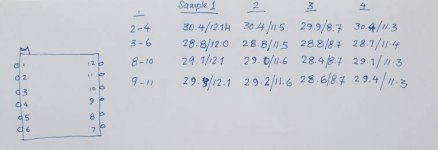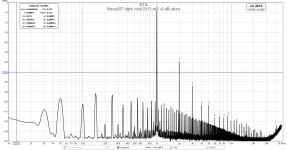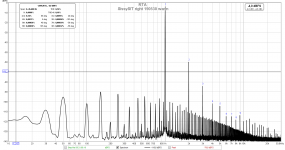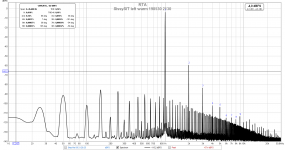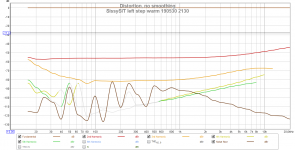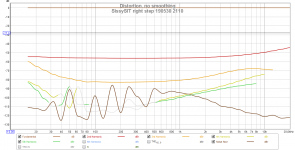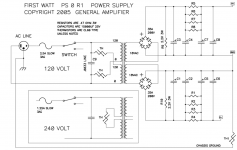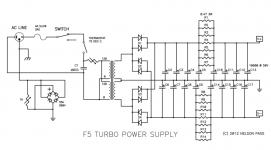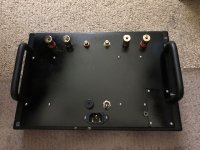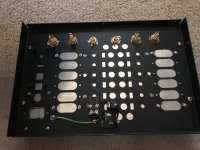Cinemag CMOQ 4LPC is quadrifillar (as confirmed by guys from factory) wound thingie , each winding having 27Rdc and 1.5H (measured by your truly )
Difference between Cinemags - CMOQ-4LPC vs. CMOQ-4HPC
If the left and right have this same value they are identical.
Attachments
Following the recent thread by XRK971 about using REW for distortion measurements here (https://www.diyaudio.com/forums/sol...-distortion-measurements-rew.html#post5806493), and making use of the opportunity that today is a holiday in our part of Germany, I did some quick measurements of my SissySIT using REW and my Focusrite 2i2.
With the amp cold, you see a clear dominance of the 2nd harmonic, and an extraordinarily low noise floor:
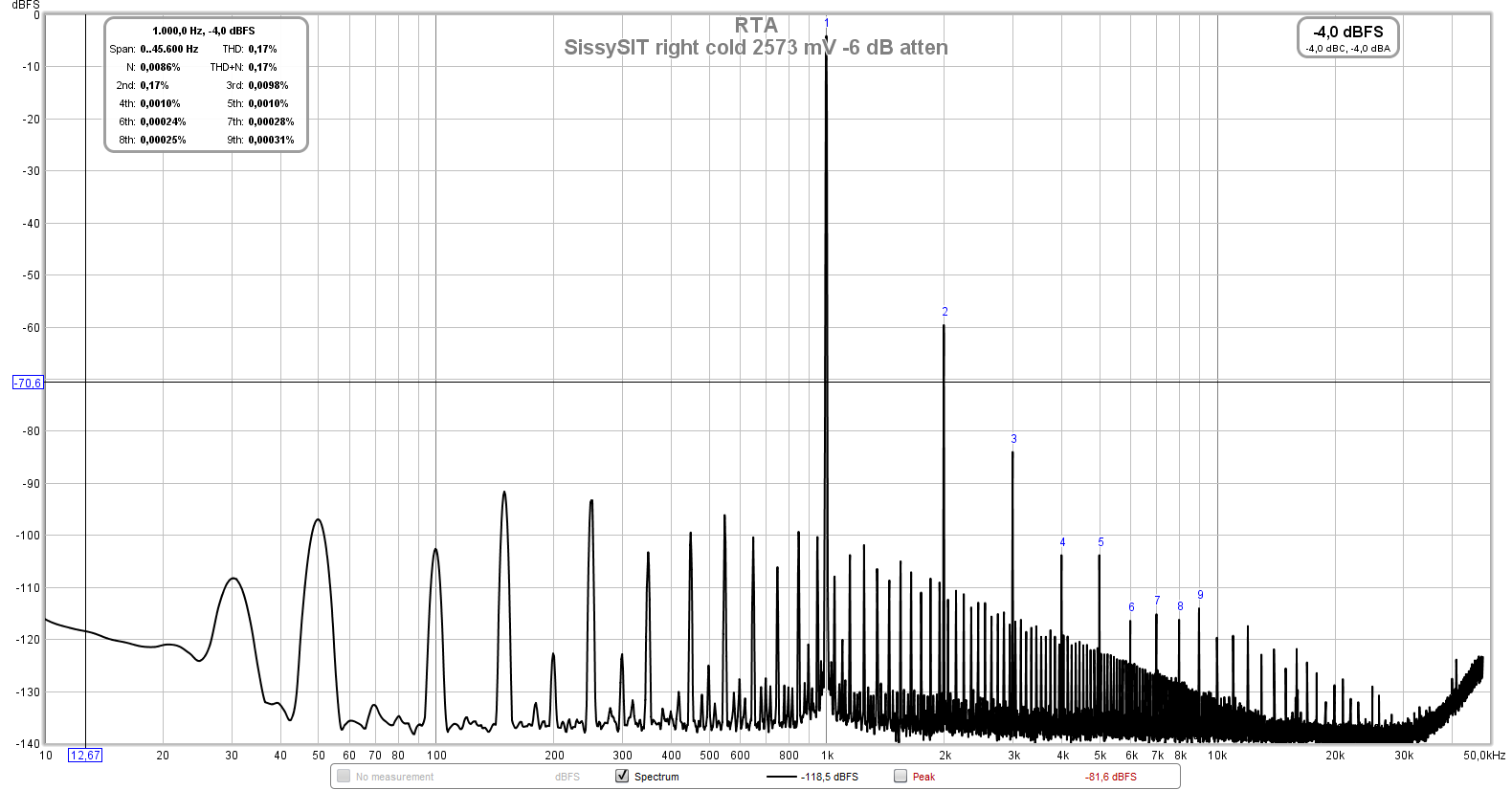
With the amp warmed up, there is really not much difference - minimally lower distortion, minimally higher noise (probably caused by the higher bias current when warm). Note the phase of the second harmonic - 86 degrees, does this mean positive phase second harmonic ?
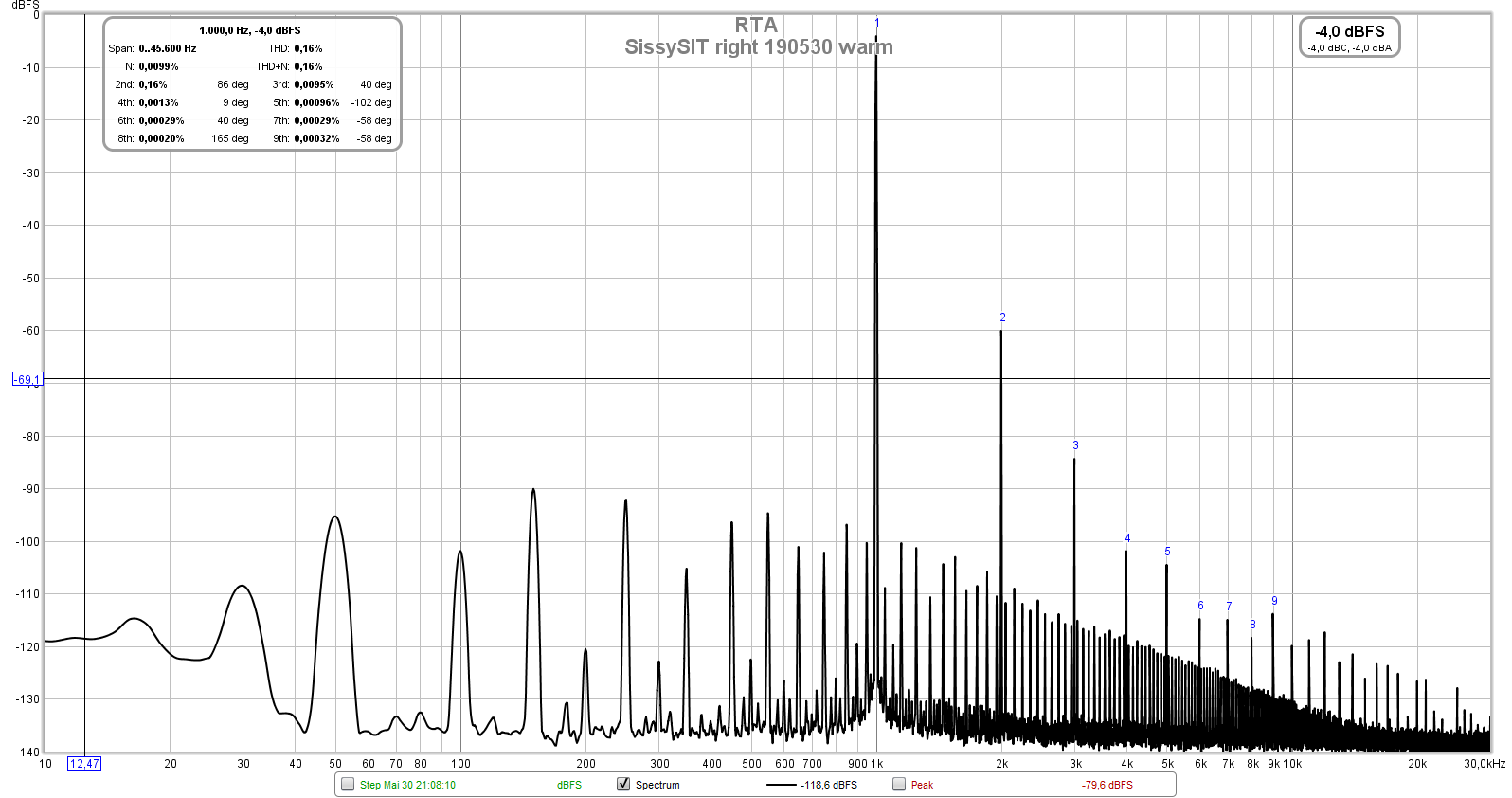
The left channel is a bit noisier (still nothing to hear with my ear in the Fostex widebanders of my 100 dB/W Jericho Horns), but otherwise superbly matched in level and distortion profile:
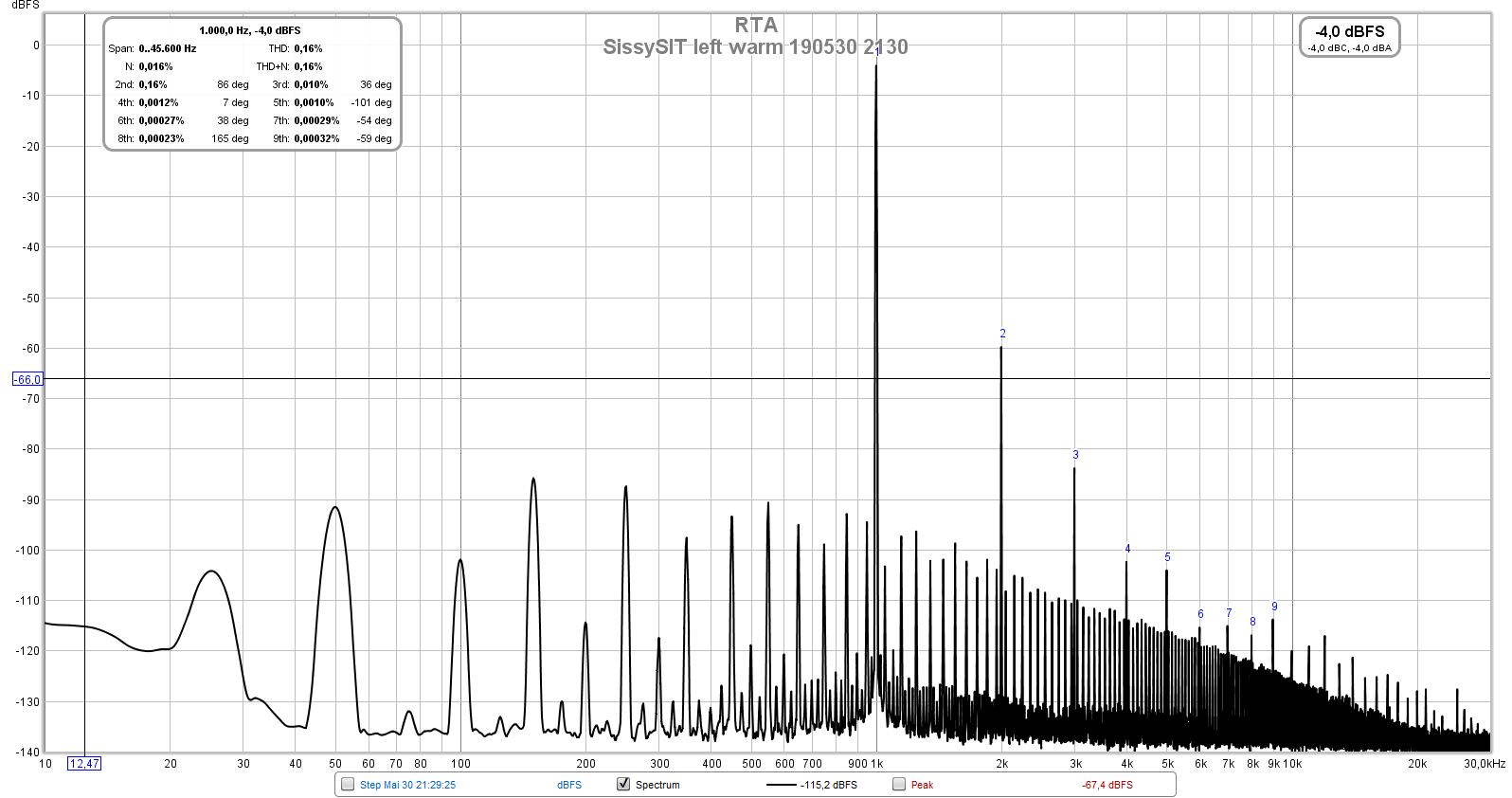
I also did a frequency sweep for both channels. For all measurements, the output of the amp was 2.58V, so a bit less than 1W over the 8.2 Ohm dummy resistors. That was the maximum level at the current setting of the Focusrite 2i2, which had been optimized for lowest noise and distortion in loopback calibrating. Could get out a bit higher level, but for "real power" I would have to add a preamp.
Anyway, here are the sweeps, first right channel:
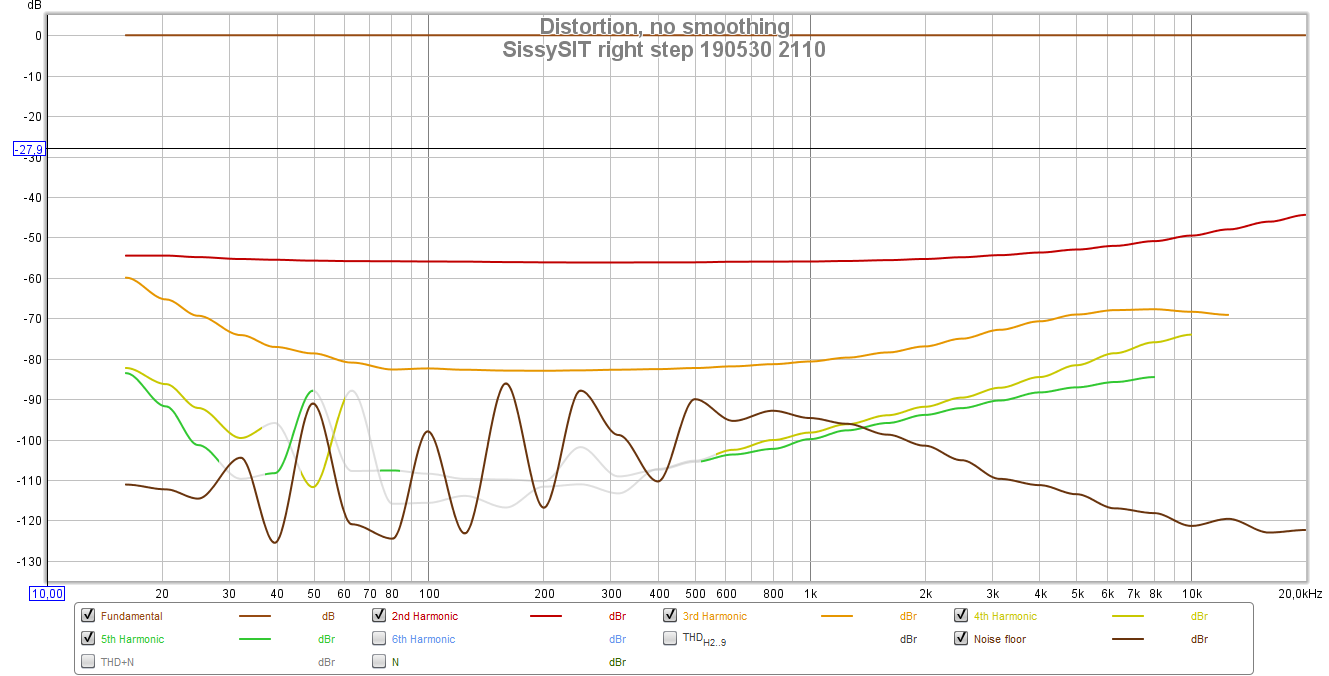
And the left:
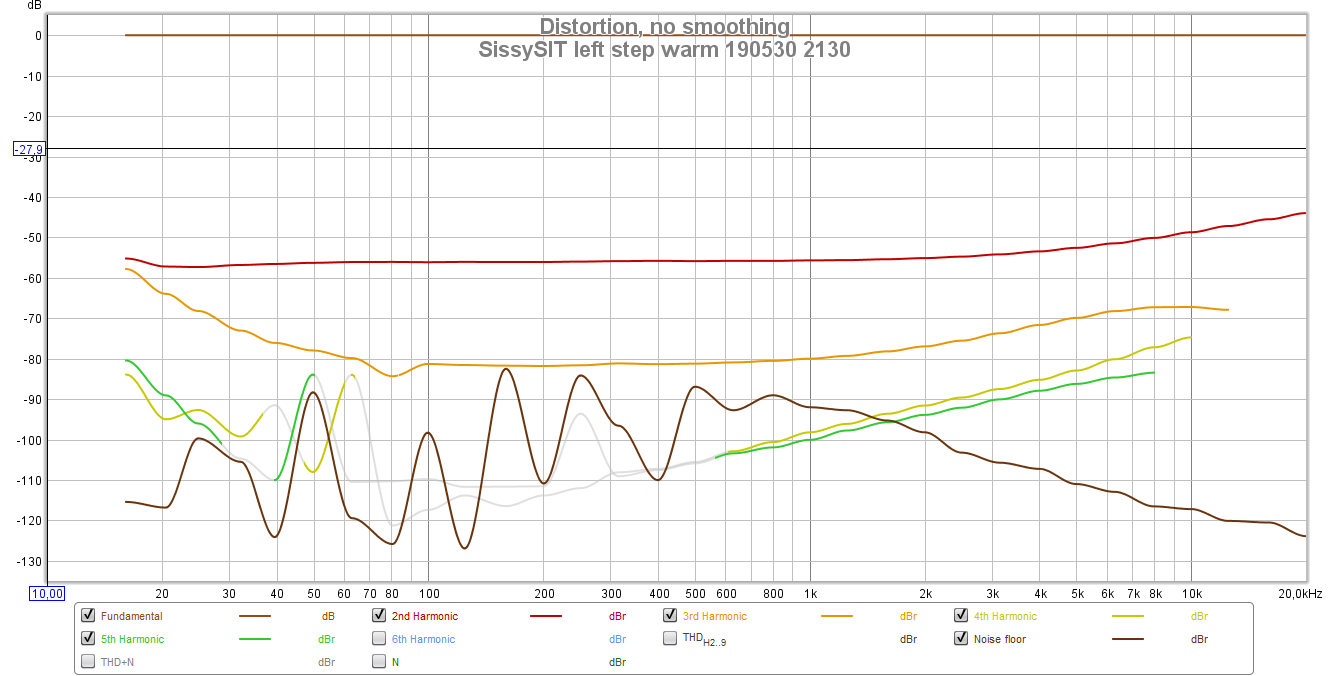
Again, I think it shows the very good matching of the two channels. Also, the lowest frequency of the sweep is 16 Hz. You see the rise of the 3rd harmonic towards the low frequencies because of the transformer used in the SissySIT, but I think the CMOQ-4HPC do show very good distortion characteristics towards low frequencies. (It was no really high input voltage, though - 0.707 V).
I found these measurements interesting .
.
And REW is easier to use for this (following XRK971's ver good intro to using it) than ARTA, which I had used before.
Best regards, Claas
With the amp cold, you see a clear dominance of the 2nd harmonic, and an extraordinarily low noise floor:
With the amp warmed up, there is really not much difference - minimally lower distortion, minimally higher noise (probably caused by the higher bias current when warm). Note the phase of the second harmonic - 86 degrees, does this mean positive phase second harmonic ?
The left channel is a bit noisier (still nothing to hear with my ear in the Fostex widebanders of my 100 dB/W Jericho Horns), but otherwise superbly matched in level and distortion profile:
I also did a frequency sweep for both channels. For all measurements, the output of the amp was 2.58V, so a bit less than 1W over the 8.2 Ohm dummy resistors. That was the maximum level at the current setting of the Focusrite 2i2, which had been optimized for lowest noise and distortion in loopback calibrating. Could get out a bit higher level, but for "real power" I would have to add a preamp.
Anyway, here are the sweeps, first right channel:
And the left:
Again, I think it shows the very good matching of the two channels. Also, the lowest frequency of the sweep is 16 Hz. You see the rise of the 3rd harmonic towards the low frequencies because of the transformer used in the SissySIT, but I think the CMOQ-4HPC do show very good distortion characteristics towards low frequencies. (It was no really high input voltage, though - 0.707 V).
I found these measurements interesting
And REW is easier to use for this (following XRK971's ver good intro to using it) than ARTA, which I had used before.
Best regards, Claas
Attachments
6SN7GTB medium-mu triode vs 6AU6A pentode

Source The Cool Sound of Tubes - IEEE Spectrum
All the harmonics (not just the 2nd harmonic) are similar to the tubes here with Sissy.
Like anything I've ever seen.
Of course the speed on these devices is not visible at this graphics. In nanoseconds for tubes and for THF.

Source The Cool Sound of Tubes - IEEE Spectrum
All the harmonics (not just the 2nd harmonic) are similar to the tubes here with Sissy.
Like anything I've ever seen.
Of course the speed on these devices is not visible at this graphics. In nanoseconds for tubes and for THF.
well done
it pretty much complies with my own measurements (even if sloppier setup) using ARTA and EMU1212 , later confirmed with my friend's measurements , using AP One setup
really lost in all files , I believe I posted those with AP somewhere
so , it is confirmed , Sissy is working well all around the Globe

(though Germany and Serbia were never too far , someone always breathing to other one's neck )
)
it pretty much complies with my own measurements (even if sloppier setup) using ARTA and EMU1212 , later confirmed with my friend's measurements , using AP One setup
really lost in all files , I believe I posted those with AP somewhere
so , it is confirmed , Sissy is working well all around the Globe

(though Germany and Serbia were never too far , someone always breathing to other one's neck
 )
)X/Chede,
Wonderful graphs. This instrument is laying bare the way tubes present sound to the listener. Actually, -55dB H2 for a 12AU7 is very good, the reflection of very high plate resistor. Most guitar amps tend to load down their plates; typically about 2.3-3 times the intrinsic plate impedance. For a 12AU7, that is 15k.
Really good work, thank you!
HD
Wonderful graphs. This instrument is laying bare the way tubes present sound to the listener. Actually, -55dB H2 for a 12AU7 is very good, the reflection of very high plate resistor. Most guitar amps tend to load down their plates; typically about 2.3-3 times the intrinsic plate impedance. For a 12AU7, that is 15k.
Really good work, thank you!
HD
Again, I think it shows the very good matching of the two channels. Also, the lowest frequency of the sweep is 16 Hz. You see the rise of the 3rd harmonic towards the low frequencies because of the transformer used in the SissySIT, but I think the CMOQ-4HPC do show very good distortion characteristics towards low frequencies.
Whether this is measured with or without the optional Borbely WCF ?
So far I did not use the Borbely buffer, just the standard version ...
Regards,
Claas
Thanks.
Everyone says they have more details without.
Although it's a taste and a loudspeaker thing.
And the measurement shows little differences.
Power Supply Question
ZM,
In your build, I see a full wave bridge rectifier on each secondary winding of the transformer and the common ground is formed between the power supply caps.
I see this is following the F5 schematic by NP.
I also see that the F5 Turbo (also by NP) uses a full wave bridge rectifier across both secondary windings with the transformer's center two leads going to ground between the power supply caps.
I will post both for comparison.
I am wondering what is preferred and why?
I'm building this amp as we speak. Stuffed boards, back panel completed, laying out bottom plate with power supply.
As you can see I have repurposed a 12 channel Sonamp 1250.
Rush
ZM,
In your build, I see a full wave bridge rectifier on each secondary winding of the transformer and the common ground is formed between the power supply caps.
I see this is following the F5 schematic by NP.
I also see that the F5 Turbo (also by NP) uses a full wave bridge rectifier across both secondary windings with the transformer's center two leads going to ground between the power supply caps.
I will post both for comparison.
I am wondering what is preferred and why?
I'm building this amp as we speak. Stuffed boards, back panel completed, laying out bottom plate with power supply.
As you can see I have repurposed a 12 channel Sonamp 1250.
Rush
Attachments
Last edited:
Pass DIY Addict
Joined 2000
Paid Member
Miko, very nice images of your amp! Thanks for sharing! One detail, though: Please upload images to the forum rather than posting external links that will surely disappear over the coming years. This way, your images will serve as a reference for more people longer into the future.
posting with phone,so short... all these pics are taken by Mighty ZM, linked in my recent post in tips and tricks thread.... or just go to SissySIT, another one | Zen Mod Blog
- Home
- Amplifiers
- Pass Labs
- SissySIT

